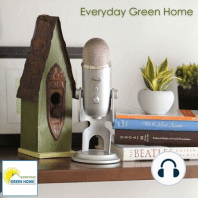41 min listen
Spring Home Maintenance with Tina Gleisner
ratings:
Length:
37 minutes
Released:
Mar 11, 2020
Format:
Podcast episode
Description
Tina Gleisner is back with us today for her second interview in our series on home maintenance. In her first interview, Tina spoke to us about home maintenance in general. In today's podcast, she shares more of her deep knowledge about home maintenance, and she continues to empower women, in particular, to take good care of their homes. The most important point The most important point to remember about taking care of your home is that you are the chief home organizer. This means that you don't have to do everything yourself. Your number one priority is to see that all the important things get done. Critical jobs Certain very critical jobs need to be done in a home, that we just don't have the tools or the experience to do. So we shouldn't even attempt to do these things. Spring maintenance The focus of today's podcast is on spring maintenance because spring is a great time to do several things on the outside of your home. Many of these things will require the assistance of an expert. Organizing your checklist It's always best to start by inspecting things around your home. Then, make a list of all the things that need to be maintained or repaired. Planning what you're going to do, and who you're going to hire to come in and help you, can minimize the costs of your ongoing home maintenance and repairs in the long run. Checking the roof If you're not comfortable on a ladder, or if there's a chance that you could fall, it's best not to go up onto the roof yourself. To check your roof, you can stand back and take some photos of it with your phone. You can then go to your computer and blow the photos up to see all the details. If you save the photos, you can use them again the next year to see if anything on the roof has changed. For most new roofs, just doing some spot-checking every year, for the first ten years, without actually going up there, will be sufficient. If you live on the coast, or in an area with harsh weather all the time, your roof will not last as long as it would in an inland area with mild weather. There's an organization called National Women In Roofing, that will help you to better understand all the different classes of roof shingles, explain what your roofing insurance will and will not cover, and answer any questions that you might have. If you need a new roof, it's never a good idea to put a second layer of roofing shingles on top of what you already have because there may be hidden damage to the plywood underneath the shingles. Remember to ask questions! A tip for recycling old roof shingles Many communities have a Roof to Roads program where they recycle asphalt shingles to be used for the building of roads. So, if you're removing an old roof, look into recycling the old shingles. Protecting the wood and checking for wood-rot If you can catch a problem early, it could save you a lot of money and effort, going forward. So check the wood around your windows and doors, and any decking or other wooden trim around the house, for signs of wood-rot that might be starting. If you find anything, it can quite easily be sanded and painted to protect the wood and prevent any deterioration. The two biggest problem areas The two biggest problem areas for wood-rot are the window-sills if the water does not roll off them fast enough, and the vertical piece of wood that is directly under the exterior doors. The longer the problem remains, the more the repair is likely to cost. Tina has an article on her website that goes into the different levels, and costs, of wood-rot on window frames. She also has a series on her website about all the different areas of wood-rot in a home. Roof flashing The flashing on the roof is usually made of thin material, like galvanized steel, and it is there to direct water away from the critical areas on the roof. Spring home-maintenance Doing outside home-maintenance in the springtime is important because you're going to start spending a lot more time outside at this time of the year.
Released:
Mar 11, 2020
Format:
Podcast episode
Titles in the series (100)
Oklahoma Green Schools with Sara Ivey: The desire to create a green and healthy environment comes to everyone from a different place, and for many of us, it was something in our childhood that initially sparked our interest. My guest for today, Sara Ivey, spent much of her childhood... by Everyday Green Home
